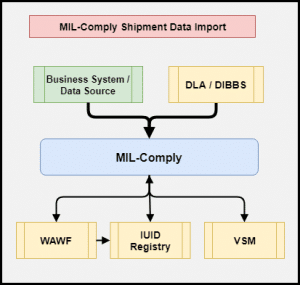MIL-Comply is a powerful stand-alone system for increasing defense shipment efficiency. Importing data from your business systems or DLA (DIBBS) can supercharge it. There is a good chance that some of the data that ends up on your Mil-Std-129 labels or submitted to Wide Area Workflow (WAWF) is already on a business system in some form, and MIL-Comply has a way to import and use it.
Higher shipment volumes place a greater importance on efficiency and accuracy. MIL-Comply offers several methods of importing data to reduce or eliminating unnecessary data-entry. These methods range in scope to discrete data items to complete shipments, depending on the source of shipment data and/or how it is maintained in your business systems.
Shipment data that can be exploited ranges from a list of the parts commonly shipped, to the IUIDs for a specific shipment, all the way to importing complete shipments. Using electronic purchase order (EDI X12-850) transactions that DLA is happy to send you can eliminate most data entry.
Here are a few ways to import shipment data into MIL-Comply:
- Import CSV files to expedite IUID labeling and WAWF submission
- Convert EDI Purchase Orders from DIBBS to eliminate 95% of data-entry.
- Shipment Templates – maintained in Shipper and Labeling for reoccurring shipments.
- Contract data maintained by Comply/Contracts.
- Reusable shipment data components (stored in databases)
- Addresses, stored by DODAAC or CAGE.
- Parts Catalog, stored by NSN or Part Number
- UIDs and/or serial numbers imported via
- Clipboard, from any number of sources
- CSV file
If you have any of this kind of data available it can probably be used to the expedite shipment processing in MIL-Comply. Complete process automation is also possible. The Compliance Print Engine will offer fully autonomous label and form printing (available in beta release 2Q 2021).


